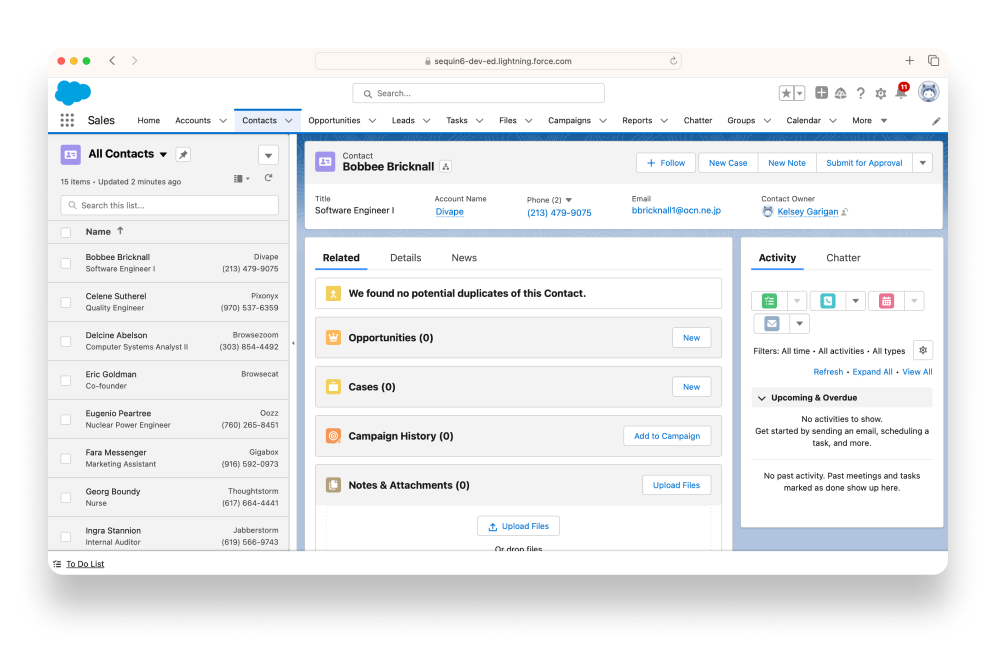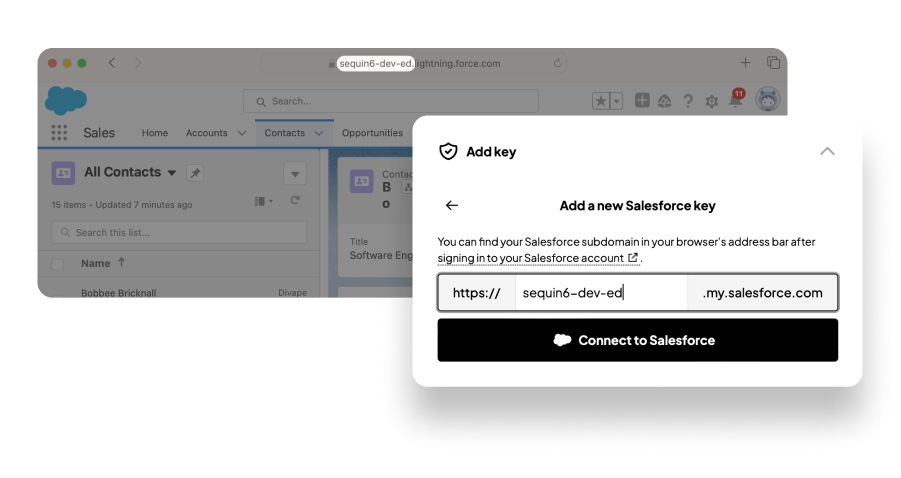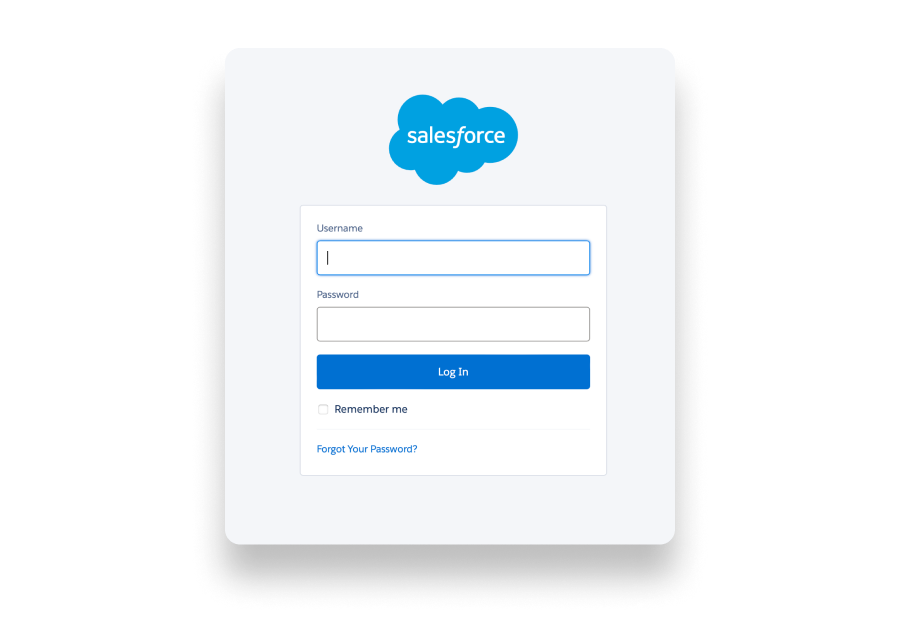In 2 minutes, you will sync all your Salesforce data to a Postgres database and can begin building on it with SQL or your favorite ORM.
This guide walks you through setting up a real-time sync between Salesforce and your database using Sequin.
In just a couple of minutes, you’ll initialize your sync, query your Salesforce data, and complete your integration by updating a Salesforce contact using the Sequin Proxy.
You’ll need to ensure that you have access to a Salesforce user with permissions to access the Salesforce API.
Create a Salesforce sync
Connect Salesforce and your database to Sequin to start your sync.
 Step 1: If you don’t have one already, create a new Sequin account at https://app.sequin.io/signup.
Step 2: Select Salesforce as the platform you want to sync.
Step 3: Now connect your Salesforce instance to Sequin by selecting Add new API key. Enter your Salesforce subdomain. You can find your Salesforce subdomain by logging into the Salesforce instance you want to sync and copying the root of the URL:
Step 1: If you don’t have one already, create a new Sequin account at https://app.sequin.io/signup.
Step 2: Select Salesforce as the platform you want to sync.
Step 3: Now connect your Salesforce instance to Sequin by selecting Add new API key. Enter your Salesforce subdomain. You can find your Salesforce subdomain by logging into the Salesforce instance you want to sync and copying the root of the URL:
 Click Connect to Salesforce and finish connecting to your Salesforce instance by entering your Salesforce credentials in the authentication modal:
Click Connect to Salesforce and finish connecting to your Salesforce instance by entering your Salesforce credentials in the authentication modal:
 Step 4: Select the Salesforce objects you want to sync to your database. Sequin syncs standard objects and custom objects to tables in your database.
Step 5: By default, Sequin syncs all the standard and custom fields of each Salesforce object to columns in your database. You can choose which fields will sync to your database and edit the column name for each field by clicking the gear icon.
Step 6: Connect to the destination database you want to sync your Salesforce data to. We suggest you sync to a database you host by choosing the Connect option and following the steps to connect to your database. Or, if you want to get up and running quickly, click the Launch option to spin up a demo database we host for you (on Amazon RDS).
Step 7: Click Create.
After you click Create, Sequin will begin backfilling all your data. We’ll show you the progress we’re making in the console. Within a minute or two, you can begin exploring your schema and querying your data in SQL. We’ll send you an email when your backfill is complete.
Step 4: Select the Salesforce objects you want to sync to your database. Sequin syncs standard objects and custom objects to tables in your database.
Step 5: By default, Sequin syncs all the standard and custom fields of each Salesforce object to columns in your database. You can choose which fields will sync to your database and edit the column name for each field by clicking the gear icon.
Step 6: Connect to the destination database you want to sync your Salesforce data to. We suggest you sync to a database you host by choosing the Connect option and following the steps to connect to your database. Or, if you want to get up and running quickly, click the Launch option to spin up a demo database we host for you (on Amazon RDS).
Step 7: Click Create.
After you click Create, Sequin will begin backfilling all your data. We’ll show you the progress we’re making in the console. Within a minute or two, you can begin exploring your schema and querying your data in SQL. We’ll send you an email when your backfill is complete.
Query your Salesforce data using SQL
Connect to your database via Sequin’s Postgres Proxy, which lets you write to your synced tables as well as read them. We’ll use psql as an example in this setup guide, but you can use any SQL client that works with Postgres.
Step 1: Go to Connection Instructions on the Sequin console. Copy the psql command to connect to your database via the Proxy.
Step 2: Open your terminal, and paste the psql command. Press Enter. This will open a connection to your database so you can write your first query:
psql -d {your_connection_string_here}
psql (14.2, server 12.11)
Type "help" for help.
dbh2vw0hqmoc9sj=>
\dt:
dbh2vw0hqmoc9sj=> \dt
List of relations
Schema | Name | Type | Owner
--------+--------------------+-------+----------
public | _sync_cdc | table | postgres
public | account | table | postgres
public | contact | table | postgres
public | lead | table | postgres
public | opportunity | table | postgres
public | user_ | table | postgres
(6 rows)
_sync tables which Sequin uses to manage your sync.
Step 4: Write your first query. You can start with a simple select to get your bearings:
dbh2vw0hqmoc9sj=> select count(*) from contact;
count
-------
15
(1 row)
api_id, first_name, and last_name for a specific customer to use in the next step:
dbh2vw0hqmoc9sj=> select api_id, first_name, last_name from contact where email = '[email protected]';
api_id | first_name | last_name
--------------------+------------+-----------
0038V00002ZBQ8pQAH | Eric | Goldman
(1 row)
api_id in the last step of this setup guide.
Write back to Salesforce
To create, update, or delete objects in Salesforce, you can insert, update, or delete rows in your Postgres database.
When you’re connected to your database through the Sequin Proxy, the Proxy listens for changes. When you make a mutation, the Proxy applies the mutation to Salesforce’s API first. If the mutation succeeds, your database is updated as well. If it fails, your database mutation will be rolled back, and you’ll receive a Postgres error.
In this example, you’ll update the contact in the prior step by giving them a new first and last name:
update contacts
set firstname = 'Sequin', lastname = 'Setup'
where id = '{{contact_id}}'
psql and check the contact you just updated:
db7hea89oah3tas=> select firstname, lastname from contact where id='{{contact_id}}';
firstname | lastname
-----------+----------
Sequin | Setup
(1 row)
Next steps
Your Salesforce tables are now available as fully readable and writeable tables in your database. You can query for all your data using SQL, and mutate data thanks to Sequin’s Postgres Proxy. To build on this foundation, here are some next steps:
- Setup your ORM to work with your synced tables.
- Edit the Salesforce objects and properties you’re syncing at any time.
- Create views on your Salesforce data to tailor your schema to your needs.
- Invite your team to your Sequin account and start building!
If you need assistance setting up your sync, just send us a note. We’re around and eager to help. 



